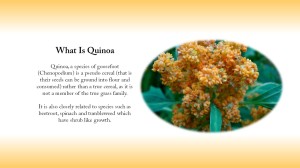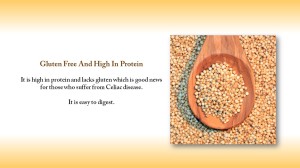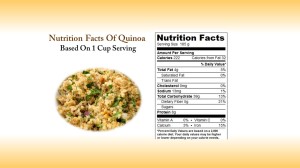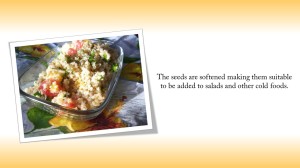What Is Quinoa?
 Make a quick search on the internet and it reveals several interesting facts about this grain crop which is grown primarily for its nutritious edible seeds.
Make a quick search on the internet and it reveals several interesting facts about this grain crop which is grown primarily for its nutritious edible seeds.
In everyday terms, Quinoa, a species of goosefoot (Chenopodium) is a pseudo cereal (that is their seeds can be ground into flour and consumed) rather than a true cereal, as it is not a member of the true grass family like wheat for instance.
It is also closely related to species such as beetroot, spinach and tumbleweed.
So Where Can it be Found Growing?
It’s origins begins in the Andean region of Ecuador, Peru, Colombia and Bolivia, where it is believed to have been domesticated some 3,000 to 4,000 years ago for human consumption and found its place into the humble Indian household (albeit as an upper middle class commodity).
Over time it has gained in popularity and has been cultivated away from its natural distribution in places like the United States, Australia and Japan to name just a few.
What are the nutritional benefits of Quinoa?
Quinoa seeds contain essential amino acids like lysine and acceptable quantities of calcium, phosphorus, and iron. Studies show that a deficiency of essential amino acids in the diet can lead to symptoms of nervousness, exhaustion, and dizziness to varying degrees and that a moderate consumption of Quinoa can help avoid these symptoms.
Anti-Inflammatory
Quinoa consists of a unique combination of anti-inflammatory compounds which research has shown to be able to decrease the risk of inflammation-related problems (including obesity) when animals under study are fed quinoa on a daily basis.
The list of anti-inflammatory phytonutrients in quinoa is now known to include:
- Polysaccharides like arabinans and rhamnogalacturonans
- Hydroxycinnamic and hydroxybenzoic acids
- Flavonoids like quercetin and kaempferol which are found in concentrated levels often higher than those of high flavonoid berries like cranberry or ligonberry
- Saponins including molecules derived from oleanic acid, hederagenin and serjanic acid.
- Small amounts of the anti-inflammatory omega-3 fatty acid, alpha-linolenic acid (ALA), are also provided by quinoa.
Good News for those with a Gluten Intolerance
 Quinoa is high in protein and lacks gluten which is good news for those who suffer from Celiac disease which is an autoimmune disease attacking the small intestine due to the presence of gluten for which the only remedy is maintaining a gluten free diet.
Quinoa is high in protein and lacks gluten which is good news for those who suffer from Celiac disease which is an autoimmune disease attacking the small intestine due to the presence of gluten for which the only remedy is maintaining a gluten free diet.
While scientists are yet to confirm whether oats are a gluten free food, it is safe to say that Quinoa, like amaranth, is gluten free and good for your health as it is considered easy to digest. Because of these characteristics, it is being considered a possible crop for long-duration human occupied space flights undertaken by NASA.
It Now Wears the ‘Super Food’ Label
The nutrient composition of Quinoa is favourable compared with common cereals earning the Quinoa grain the title of being called a “super food”.
Nutritional evaluations indicate that quinoa is a complete protein source. That is, it contains all the essential amino acids required in a human diet in the correct proportions.
Other similar pseudo grains derived from seeds are similar in complete protein levels; buckwheat is 18% protein compared to 14% for Quinoa; Amaranth, a related species to Quinoa, ranges from 12 to 17.5%.
High In Protein
The protein content per 100 calories is higher than brown rice, potatoes, barley and millet, but is less than wild rice (Indian rice) and oats. Compared to other cereal crops like wheat, quinoa has a higher fat content and is able to provide useful measures of fats which are good for the heart in the form of oleic acid (e.g. monounsaturated fat).
High In Fibre – Good for the Gut
The grain is additionally an excellent source of dietary fibre and phosphorus and is also high in magnesium and iron.
Vegan Friendly and Good For Those Who Are Lactose Intolerant
It is also a source of calcium, and thus, is useful for vegans and those who are lactose intolerant.
Exactly How Do You Eat Quinoa?
The grain may be germinated in its raw form to boost its nutritional value, provided the grains are rinsed thoroughly to remove any saponin that contains an unpalatable bitterness which in turn aids during cultivation as it wards off birds reducing the need for protecting it.
The seeds are in general cooked the same way as rice and can be used in a wide range of dishes. Just follow the directions on the packet is best. For extra flavour I often cook it in chicken or vegetable stock at the rate of three to one (3 parts liquid to one part quinoa).
The good news is the normal cooking processes of simmering, steaming and boiling quinoa don’t appear to significantly affect the quality of quinoa’s fatty acids so this allows us to enjoy its nice nutty texture and flavour when cooked while still maintaining this important nutrient benefits.
Quinoa leaves are eaten as a leaf vegetable, much like amaranth, but the commercial availability of quinoa greens is limited. Cooked quinoa seeds are also great for adding to salads and other cold foods instead of rice or pasta and you can also use it as a breakfast cereal.
What Makes Quinoa Special?
While it may be called a “Pseudo-cereal” there is nothing fake about the health benefits of Quinoa. In fact, The Food and Agricultural Organization of the United Nations (FAO) has officially declared that the year 2013 be recognized as “The International Year of the Quinoa.”
So if you haven’t tried Quinoa yet then give it a go – you will be pleasantly surprised.


Leave a Reply